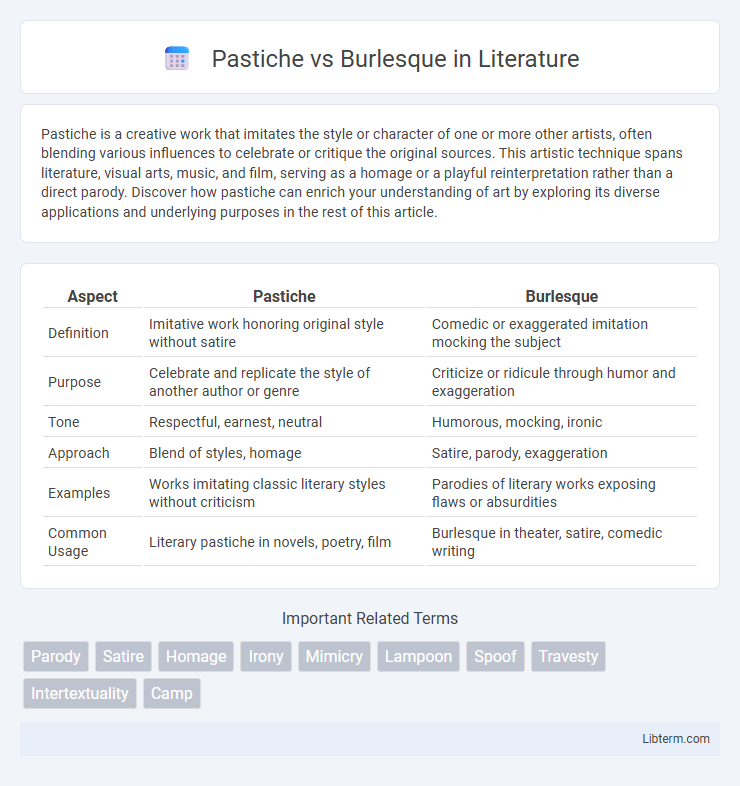Pastiche is a creative work that imitates the style or character of one or more other artists, often blending various influences to celebrate or critique the original sources. This artistic technique spans literature, visual arts, music, and film, serving as a homage or a playful reinterpretation rather than a direct parody. Discover how pastiche can enrich your understanding of art by exploring its diverse applications and underlying purposes in the rest of this article.
Table of Comparison
| Aspect | Pastiche | Burlesque |
|---|---|---|
| Definition | Imitative work honoring original style without satire | Comedic or exaggerated imitation mocking the subject |
| Purpose | Celebrate and replicate the style of another author or genre | Criticize or ridicule through humor and exaggeration |
| Tone | Respectful, earnest, neutral | Humorous, mocking, ironic |
| Approach | Blend of styles, homage | Satire, parody, exaggeration |
| Examples | Works imitating classic literary styles without criticism | Parodies of literary works exposing flaws or absurdities |
| Common Usage | Literary pastiche in novels, poetry, film | Burlesque in theater, satire, comedic writing |
Defining Pastiche and Burlesque
Pastiche is a literary or artistic work that imitates the style or character of one or more other artists, often as a respectful homage or celebration, blending various influences without parodying the original content. Burlesque, in contrast, is a form of satire that exaggerates and mocks its subject by using humor, caricature, and absurdity to highlight flaws or social issues. Both pastiche and burlesque manipulate established styles, but pastiche emphasizes imitation and admiration while burlesque focuses on comedic critique.
Origins and Historical Context
Pastiche originated in the Renaissance as an artistic work imitating the style of various authors or artists, reflecting admiration rather than critique. Burlesque emerged in the 17th century as a theatrical form that used exaggerated parody and humor to ridicule serious subjects and social norms. Both forms evolved through different cultural contexts, with pastiche emphasizing homage and burlesque focusing on satire and comedic distortion.
Key Characteristics of Pastiche
Pastiche is a literary or artistic work that imitates the style or character of one or more other works, often as a form of homage without satire or ridicule. Its key characteristics include the respectful mimicry of distinctive styles, diverse influences combined into a cohesive piece, and a focus on celebrating rather than mocking the source material. Unlike burlesque, which exaggerates and parodies for comedic effect, pastiche maintains a sincere tone and reverence for the original inspirations.
Distinct Features of Burlesque
Burlesque is characterized by its satirical and exaggerated imitation of serious works, often incorporating humor, parody, and theatrical performance to critique cultural or social norms. It typically involves elements such as comedic sketches, musical numbers, and provocative costumes that emphasize irony and exaggeration. Unlike pastiche, which imitates style without satire, burlesque actively mocks its subjects while entertaining through bold, exaggerated artistry.
Purpose and Intent in Both Forms
Pastiche imitates stylistic elements of other works to honor or celebrate the original, often functioning as a respectful tribute or creative homage within literature, film, and art. Burlesque, conversely, aims to ridicule or lampoon its subject through exaggerated imitation, employing humor and satire to critique societal norms or specific genres. Both forms manipulate imitation but diverge fundamentally in purpose: pastiche seeks admiration and continuity, while burlesque pursues mockery and subversion.
Examples in Literature and Art
Pastiche in literature and art imitates the style or character of other works, seen in Michael Chabon's *The Amazing Adventures of Kavalier & Clay*, which blends pulp fiction elements with historical narrative. Burlesque employs exaggerated parody or satire, exemplified by Alexander Pope's *The Rape of the Lock*, which mocks high society through humorous exaggeration. Both forms rely on intertextual references but pastiche reveres original styles, while burlesque distorts them for comic or critical effect.
The Role of Imitation and Parody
Pastiche employs imitation by blending styles and elements from various works in a respectful, celebratory manner, creating a collage that honors the original sources without mocking them. Burlesque uses parody through exaggerated imitation, often ridiculing or satirizing its subjects to provoke humor or criticism. The role of imitation in pastiche is homage and fusion, while in burlesque it is criticism and comedic distortion.
Audience Reception and Interpretation
Pastiche often invites audiences to appreciate homage and stylistic imitation, eliciting recognition and nostalgia through its respectful reassembly of existing genres or works. Burlesque, by contrast, provokes laughter and critical reflection by exaggerating and mocking its subjects, often challenging societal norms and expectations. Audience interpretation hinges on familiarity with the source material; pastiche thrives on shared cultural knowledge, while burlesque leverages satire to subvert audience perceptions.
Pastiche vs Burlesque in Modern Culture
Pastiche in modern culture imitates the style or character of other works, often celebrating or paying homage to them, while burlesque uses exaggeration and parody to mock or critique. Pastiche embraces diversity of influences in contemporary media, blending genres without direct satire, whereas burlesque highlights social or cultural issues through humor and caricature. These distinct approaches shape how artists and audiences engage with media, reflecting varied attitudes toward tradition and innovation.
Choosing Between the Two: Creative Considerations
Choosing between pastiche and burlesque depends on the desired tone and purpose of the creative work. Pastiche involves respectful imitation of a particular style or genre, emphasizing homage and subtlety, ideal for creators aiming to celebrate or explore the original work's nuances. Burlesque, characterized by exaggeration and parody, suits projects that seek humor, satire, or social critique through distortion and comic transformation.
Pastiche Infographic

 libterm.com
libterm.com